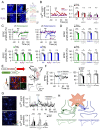Spatial organization of neuron-astrocyte interactions in the somatosensory cortex
- PMID: 36124663
- PMCID: PMC10110431
- DOI: 10.1093/cercor/bhac357
Spatial organization of neuron-astrocyte interactions in the somatosensory cortex
Abstract
Microcircuits in the neocortex are functionally organized along layers and columns, which are the fundamental modules of cortical information processing. While the function of cortical microcircuits has focused on neuronal elements, much less is known about the functional organization of astrocytes and their bidirectional interaction with neurons. Here, we show that Cannabinoid type 1 receptor (CB1R)-mediated astrocyte activation by neuron-released endocannabinoids elevate astrocyte Ca2+ levels, stimulate ATP/adenosine release as gliotransmitters, and transiently depress synaptic transmission in layer 5 pyramidal neurons at relatively distant synapses (˃20 μm) from the stimulated neuron. This astrocyte-mediated heteroneuronal synaptic depression occurred between pyramidal neurons within a cortical column and was absent in neurons belonging to adjacent cortical columns. Moreover, this form of heteroneuronal synaptic depression occurs between neurons located in particular layers, following a specific connectivity pattern that depends on a layer-specific neuron-to-astrocyte signaling. These results unravel the existence of astrocyte-mediated nonsynaptic communication between cortical neurons and that this communication is column- and layer-specific, which adds further complexity to the intercellular signaling processes in the neocortex.
Keywords: astrocyte; calcium imaging; cortex; neuron-astrocyte communication; synaptic transmission.
© The Author(s) 2022. Published by Oxford University Press. All rights reserved. For permissions, please e-mail: journals.permissions@oup.com.
Figures






Similar articles
-
Astrocyte Signaling Gates Long-Term Depression at Corticostriatal Synapses of the Direct Pathway.J Neurosci. 2020 Jul 22;40(30):5757-5768. doi: 10.1523/JNEUROSCI.2369-19.2020. Epub 2020 Jun 15. J Neurosci. 2020. PMID: 32541069 Free PMC article.
-
Lateral regulation of synaptic transmission by astrocytes.Neuroscience. 2016 May 26;323:62-6. doi: 10.1016/j.neuroscience.2015.02.036. Epub 2015 Feb 27. Neuroscience. 2016. PMID: 25732135
-
Neuron-astrocyte signaling is preserved in the aging brain.Glia. 2017 Apr;65(4):569-580. doi: 10.1002/glia.23112. Epub 2017 Jan 28. Glia. 2017. PMID: 28130845 Free PMC article.
-
Astrocytes in endocannabinoid signalling.Philos Trans R Soc Lond B Biol Sci. 2014 Oct 19;369(1654):20130599. doi: 10.1098/rstb.2013.0599. Philos Trans R Soc Lond B Biol Sci. 2014. PMID: 25225093 Free PMC article. Review.
-
Diversity and Specificity of Astrocyte-neuron Communication.Neuroscience. 2019 Jan 1;396:73-78. doi: 10.1016/j.neuroscience.2018.11.010. Epub 2018 Nov 17. Neuroscience. 2019. PMID: 30458223 Free PMC article. Review.
Cited by
-
Rethinking Sensory Information Processing: The Essential Role of Astrocytes.J Neurochem. 2025 Jun;169(6):e70113. doi: 10.1111/jnc.70113. J Neurochem. 2025. PMID: 40490971 Free PMC article. Review.
-
Estradiol Mediates Astrocyte-Neuron Communication in the Hippocampus.Mol Neurobiol. 2025 Aug;62(8):10468-10483. doi: 10.1007/s12035-025-04905-6. Epub 2025 Apr 10. Mol Neurobiol. 2025. PMID: 40208551 Free PMC article.
-
Concentration-dependent bidirectional modification of evoked synaptic transmission by gadolinium and adverse effects of gadolinium-based contrast agent.J Neurosci. 2025 Mar 17;45(17):e1622242025. doi: 10.1523/JNEUROSCI.1622-24.2025. Online ahead of print. J Neurosci. 2025. PMID: 40097182
-
Extracellular glutamate is not modulated by cannabinoid receptor activity.Sci Rep. 2024 Nov 6;14(1):26889. doi: 10.1038/s41598-024-75962-5. Sci Rep. 2024. PMID: 39505963 Free PMC article.
-
A spatial threshold for astrocyte calcium surge.Elife. 2024 Dec 16;12:RP90046. doi: 10.7554/eLife.90046. Elife. 2024. PMID: 39680037 Free PMC article.
References
-
- Alger BE. Retrograde signaling in the regulation of synaptic transmission: focus on endocannabinoids. Prog Neurobiol. 2002:68(4):247–286. - PubMed
Publication types
MeSH terms
Grants and funding
LinkOut - more resources
Full Text Sources
Miscellaneous

